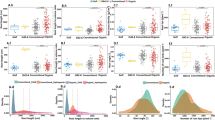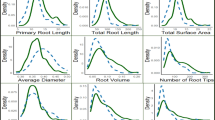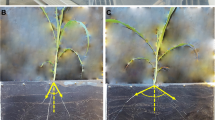Abstract
Main conclusion
Soil acidity in Ethiopian highlands impacts barley production, affecting root system architecture. Study on 300 accessions showed significant trait variability, with potential for breeding enhancement.
Abstract
Soil acidity poses a significant challenge to crop production in the highland regions of Ethiopia, particularly impacting barley, a crucial staple crop. This acidity serves as a key stressor affecting the root system architecture (RSA) of this crop. Hence, the objective of this study was to assess the RSA traits variability under acidic soil conditions using 300 barley accessions in a greenhouse experiment. The analysis of variance indicated substantial variations among the accessions across all traits studied. The phenotypic coefficient of variation ranged from 24.4% for shoot dry weight to 11.1% for root length, while the genotypic coefficient variation varied between 18.83 and 9.2% for shoot dry weight and root length, respectively. The broad-sense heritability ranged from 36.7% for leaf area to 69.9% for root length, highlighting considerable heritability among multiple traits. The genetic advances as a percent of the mean ranged from 13.63 to 29.9%, suggesting potential for enhancement of these traits through breeding efforts. Principal component analysis and cluster analysis grouped the genotypes into two major clusters, each containing varying numbers of genotypes with contrasting traits. This diverse group presents an opportunity to access a wide range of potential parent candidates to enhance genetic variablity in breeding programs. The Pearson correlation analysis revealed significant negative associations between root angle (RA) and other RSA traits. This helps indirect selection of accessions for further improvement in soil acidity. In conclusion, this study offers valuable insights into the RSA characteristics of barley in acidic soil conditions, aiding in the development of breeding strategies to enhance crop productivity in acidic soil environments.







Similar content being viewed by others
Data availability
All materials used in this finding attached as supplementary materials.
Abbreviations
- GCV:
-
Genotypic coefficients of variation
- PCV:
-
Phenotypic coefficients of variation
- RA:
-
Root angle
- RSA:
-
Root system architecture
References
Abate E, Hussien S, Laing M, Mengistu F (2013) Aluminium toxicity tolerance in cereals: mechanisms, genetic control and breeding methods. Afr J Agric Res 8(9):711–722. https://doi.org/10.5897/AJARx12.003
Abdel-Ghani AH, Sharma R, Wabila C, Dhanagond S, Owais SJ, Duwayri MA et al (2019) Genome-wide association mapping in a diverse spring barley collection reveals the presence of QTL hotspots and candidate genes for root and shoot architecture traits at seedling stage. BMC Plant Biol 19:1–19. https://doi.org/10.1186/s12870-019-1828-5
Abebe TD, Mathew B, Léon J (2012) Barrier analysis detected genetic discontinuity among Ethiopian barley (Hordeum vulgare L.) landraces due to landscape and human mobility on gene flow. Genet Resour Crop Evol 60(1):297–309. https://doi.org/10.1007/s10722-012-9834-6
Ahmad S, Ali H, Ur Rehman A, Khan RJZ, Ahmad W, Fatima Z et al (2015) Measuring leaf area of winter cereals by different techniques: a comparison. Pak J Life Soc Sci 13(2):117–125
Alemu G, Desalegn T, Debele T, Adela A, Taye G, Yirga C (2017) Effect of lime and phosphorus fertilizer on acid soil properties and barley grain yield at Bedi in western Ethiopia. Afr J Agric Res 12(40):3005–3012. https://doi.org/10.5897/AJAR2017.12562
Alemu A, Nebiyu A, Getachew M (2018) Growth and yield of common bean (Phaseolus vulgaris L.) cultivars as influenced by rates of phosphorus at Jimma, Southwest Ethiopia. J Agric Biotech Sustain Dev 6:104–115. https://doi.org/10.5897/JABSD2018.0312
Ali ML, Luetchens J, Nascimento J, Shaver TM, Kruger GR, Lorenz AJ (2015) Genetic variation in seminal and nodal root angle and their association with grain yield of maize under water-stressed field conditions. Plant Soil 397(1–2):213–225. https://doi.org/10.1007/s11104-015-2554-x
Alvarado G, Rodriguez FM, Pacheco A, Burgueño J, Crossa J, Vargas M et al (2020) META-R: a software to analyze data from multi-environment plant breeding trials. Crop J 8(5):745–756. https://doi.org/10.1016/j.cj.2020.03.010
Angassa D, Tesfaye K (2019) Diversity study of some Ethiopian barley (Hordeum vulgare (L.)) accessions for their agronomical important traits. Int J Agric Innov Res 8(1):2319–1473
Baldwin CM, Liu H, McCarty LB, Luo H, Wells CE, Toler JE (2009) Impacts of altered light spectral quality on warm season turfgrass growth under greenhouse conditions. Crop Sci 49(4):1444–1453. https://doi.org/10.2135/cropsci2008.07.0412
Balsberg-Påhlsson A-M (1995) Growth, radicle and root hair development of Deschampsia flexuosa (L.) Trin. seedlings in relation to soil acidity. Plant Soil 175:125–132. https://doi.org/10.1007/BF02413017
Bates D (2016) lme4: Linear mixed‐effects models using Eigen and S4. R package version 1: 1. https://github.com/lme4/lme4/
Begna T C (2023) Genetic variability analysis of elite sorghum (Sorghum bicolor (L) Moench) genotypes under dry lowland areas of Ethiopia. Begna, Available at SSRN: https://ssrn.com/abstract=4432312 or https://doi.org/10.2139/ssrn.4432312
Bian M, Waters I, Broughton S, Zhang X-Q, Zhou M, Lance R et al (2013) Development of gene-specific markers for acid soil/aluminium tolerance in barley (Hordeum vulgare L.). Mol Breed 32:155–164. https://doi.org/10.1007/s11032-013-9859-3
Bona L, Wright R, Baligar V, Matuz J (1993) Screening wheat and other small grains for acid soil tolerance. Landsc Urban Plan 27(2–4):175–178
Breuning Madsen H (1985) Distribution of spring barley roots in Danish soils, of different texture and under different climatic conditions. Plant Soil 88:31–43. https://doi.org/10.1007/BF02140664
Butler D, Cullis BR, Gilmour A, Gogel B (2009) ASReml-R reference manual. The State of Queensland, Department of Primary Industries and Fisheries, Brisbane
Chimdi A, Gebrekidan H, Kibret K, Tadesse A (2012) Response of barley to liming of acid soils collected from different land use systems of Western Oromia, Ethiopia. J Biodiver Env Sci 2(7):1–13
Christopher J, Christopher M, Jennings R, Jones S, Fletcher S, Borrell A et al (2013) QTL for root angle and number in a population developed from bread wheats (Triticum aestivum) with contrasting adaptation to water-limited environments. Theor Appl Genet 126(6):1563–1574. https://doi.org/10.1007/s00122-013-2074-0
Delhaize E, James RA, Ryan PR (2012) Aluminium tolerance of root hairs underlies genotypic differences in rhizosheath size of wheat (Triticum aestivum) grown on acid soil. New Phytol 195(3):609–619. https://doi.org/10.1111/j.1469-8137.2012.04183.x
Demelash H, Tadesse T, Menamo T, Menzir A (2021) Determination of root system architecture variation of drought adapted sorghum genotypes using high throughput root phenotyping. Rhizosphere 19:100370. https://doi.org/10.1016/j.rhisph.2021.100370
Demelash H, Gedifew S, Menamo T, Tadesse T (2023) Multivariate analysis of root system architectural traits of sorghum for drought tolerance. Genet Resour Crop Evol 71:471–480. https://doi.org/10.1007/s10722-023-01640-6
Dunbabin VM, Postma JA, Schnepf A, Pagès L, Javaux M, Wu L et al (2013) Modelling root–soil interactions using three-dimensional models of root growth, architecture and function. Plant Soil 372:93–124. https://doi.org/10.1007/s11104-013-1769-y
Elias M, Lule D, Tirfessa A, Gelmesa D, Tesso T, Menamo T et al (2023) Genetic diversity in Ethiopian sorghum germplasm for root system architecture and trait association. Rhizosphere 27:100759. https://doi.org/10.1016/j.rhisph.2023.100759
Elias M, Chere D, Lule D, Serba D, Tirfessa A, Gelmesa D et al (2024) Multi-locus genome-wide association study reveal genomic regions underlying root system architecture traits in Ethiopian sorghum germplasm. Plant Genome. https://doi.org/10.1002/tpg2.20436
Eticha F, Berghofer E, Grausgruber H (2009) Utilization of barley (Hordeum vulgare L.) landraces in the highlands of West Shewa, Ethiopia. Plant Genet Res 7(2):154–162. https://doi.org/10.1017/S1479262108123474
Faostat F (2022) Agriculture Organization of the United Nations, 2022. FAO, Retrieved from http://faostat3.fao.org/faostat-gateway/go/to/download/Q/QC/S
Fekadu W, Mekbib F, Lakew B, Haussmann BI (2022) Assessment of genetic variability and acid soil tolerance in Ethiopian barley landraces. Ethiop J Agric Sci 32(4):1–29
Gadissa F, Abebe M, Bekele T (2021) Agro-morphological traits-based genetic diversity assessment in Ethiopian barley (Hordeum vulgare L.) landrace collections from Bale highlands, Southeast Ethiopia. Agric Food Secur 10(1):1–14. https://doi.org/10.1186/s40066-021-00335-4
Gnanasekaran M, Thiyagu K, Gunasekaran M (2018) Genetic variability heritability and genetic advance studies in cotton (Gossypium hirsutum L.). J Plant Breed 9(1):377. https://doi.org/10.5958/0975-928x.2018.00043.1
Gregory A, Watts C, Whalley W, Kuan H, Griffiths B, Hallett P et al (2007) Physical resilience of soil to field compaction and the interactions with plant growth and microbial community structure. Eur J Soil Sci 58(6):1221–1232. https://doi.org/10.1111/j.1365-2389.2007.00956.x
Haling RE (2011) Root growth of perennial grasses in acid, high-strength soils and the application of molecular-based assays to quantitative root studies, University of Western Australia
Haling RE, Richardson AE, Culvenor RA, Lambers H, Simpson RJ (2010) Root morphology, root-hair development and rhizosheath formation on perennial grass seedlings is influenced by soil acidity. Plant Soil 335:457–468. https://doi.org/10.1007/s11104-010-0433-z
Hargreaves CE, Gregory PJ, Bengough AG (2009) Measuring root traits in barley (Hordeum vulgare ssp. vulgare and ssp. spontaneum) seedlings using gel chambers, soil sacs and X-ray microtomography. Plant Soil 316:285–297. https://doi.org/10.1007/s11104-008-9780-4
Jia Z, Liu Y, Gruber BD, Neumann K, Kilian B, Graner A et al (2019) Genetic dissection of root system architectural traits in spring barley. Front Plant Sci 10:400. https://doi.org/10.3389/fpls.2019.00400
Johnson HW, Robinson H, Comstock R (1955) Estimates of genetic and environmental variability in soybeans 1. Agron J 47(7):314–318
Kassa Cholbe M, Kebede Yeme F, Haile Woldeyohannes W (2020) Fertility status of acid soils under different land use types in Wolaita zone, Southern Ethiopia. Appl Environ Soil Sci 2020:1–9. https://doi.org/10.1155/2020/3713967
Kassambara A, Mundt F (2017) Package ‘factoextra’. Extract and visualize the results of multivariate data analyses. http://www.sthda.com/english/rpkgs/factoextra
Kemmitt SJ, Wright D, Goulding KW, Jones DL (2006) pH regulation of carbon and nitrogen dynamics in two agricultural soils. Soil Biol Biochem 38(5):898–911. https://doi.org/10.1016/j.soilbio.2005.08.006
Kumar M, Vishwakarma SR, Bhushan B, Kumar A (2013) Estimation of genetic parameters and character association in barley (Hordeum vulgare L.). J Wheat Res 5(2):76–78. https://epubs.icar.org.in/index.php/JWR/article/view/36775
Kuznetsova A, Brockhoff PB, Christensen RH (2017) lmerTest package: tests in linear mixed effects models. J Stat Software 82:1–26. https://doi.org/10.18637/jss.v082.i13
Lynch JP, Brown KM (2012) New roots for agriculture: exploiting the root phenome. Philos Trans R Soc Lond B Biol Sci 367(1595):1598–1604. https://doi.org/10.1098/rstb.2011.0243
Lynch JP, Wojciechowski T (2015) Opportunities and challenges in the subsoil: pathways to deeper rooted crops. J Exp Bot 66(8):2199–2210. https://doi.org/10.1093/jxb/eru508
Manoharan V, Loganathan P, Tillman R, Parfitt R (2007) Interactive effects of soil acidity and fluoride on soil solution aluminium chemistry and barley (Hordeum vulgare L.) root growth. Environ Pollut 145(3):778–786. https://doi.org/10.1016/j.envpol.2006.05.015
Manschadi AM, Hammer GL, Christopher JT (2008) Genotypic variation in seedling root architectural traits and implications for drought adaptation in wheat (Triticum aestivum L.). Plant Soil 303(1–2):115–129. https://doi.org/10.1007/s11104-007-9492-1
Manschadi AM, Kaul H-P, Vollmann J, Eitzinger J, Wenzel W (2014) Developing phosphorus-efficient crop varieties—an interdisciplinary research framework. Field Crops Res 162:87–98. https://doi.org/10.1016/j.fcr.2013.12.016
Menamo T, Borrell AK, Mace E, Jordan DR, Tao Y, Hunt C et al (2023) Genetic dissection of root architecture in Ethiopian sorghum landraces. Theor Appl Genet 136(10):209. https://doi.org/10.1007/s00122-023-04457-0
Moroni J, Sato K, Scott B, Conyers M, Read B, Fisher R et al (2010) Novel barley (Hordeum vulgare L.) germplasm resistant to acidic soil. Crop Pasture Sci 61(7):540–553. https://doi.org/10.1071/CP10003
Mulima E, Sibiya J, Musvosvi C, Nhamucho E (2018) Identification of important morphological traits in Mozambican sorghum [Sorghum bicolor (L.) Moench] germplasm using multivariate analysis. Afr J Agric Res 13(34):1796–1810. https://doi.org/10.5897/AJAR2018.13316
Muñoz-Amatriaín M, Cuesta-Marcos A, Endelman JB, Comadran J, Bonman JM, Bockelman HE et al (2014) The USDA barley core collection: genetic diversity, population structure, and potential for genome-wide association studies. PLoS ONE 9(4):e94688. https://doi.org/10.1371/journal.pone.0094688
Pereira JF (2018) Initial root length in wheat is highly correlated with acid soil tolerance in the field. Scientia Agricola 75:79–83. https://doi.org/10.1590/1678-992X-2016-0422
Pessarakli M, Kopec D (2007) Establishment of three warm-season grasses under salinity stress. II International Conference on Turfgrass Science and Management for Sports Fields. ISHS Acta Horticulturae. https://doi.org/10.17660/ActaHortic.2008.783.2
Richardson AE, Lynch JP, Ryan PR, Delhaize E, Smith FA, Smith SE et al (2011) Plant and microbial strategies to improve the phosphorus efficiency of agriculture. Plant Soil 349:121–156. https://doi.org/10.1007/s11104-011-0950-4
Robinson H, Hickey L, Richard C, Mace E, Kelly A, Borrell A et al (2016) Genomic regions influencing seminal root traits in barley. Plant Genome. https://doi.org/10.3835/plantgenome2015.03.0012
Robinson H, Kelly A, Fox G, Franckowiak J, Borrell A, Hickey L (2018b) Root architectural traits and yield: exploring the relationship in barley breeding trials. Euphytica 214:1–16. https://doi.org/10.1007/s10681-018-2219-y
Robinson H, Kandic V, Christopher J, Fox G, Kelly A, Borrell A et al (2018a) Root traits for yield improvement in barley. GRDC Update Papers
Sharma V, Semwal C, Uniyal S (2010) Genetic variability and character association analysis in bell pepper (Capsicum annuum L.). J Hortic For 2(3): 58–65. http://www.academicjournals.org/jhf
Shewayrga H, Sopade PA (2011) Ethnobotany, diverse food uses, claimed health benefits and implications on conservation of barley landraces in North Eastern Ethiopia highlands. J Ethnobiol Ethnomed 7(19):1–15. https://doi.org/10.1186/1746-4269-7-19
Shiferaw T, Tadele M (2022) Genetic diversity of Ethiopian barley (Hordeum vulgare L.) genotypes based on multivariate statistical analysis for acid soil tolerance. J Plant Biol Crop Res 4(2):1047
Singh M, Kumar S (2016) Broadening the genetic base of grain cereals. Springer, New Delhi. https://doi.org/10.1007/978-81-322-3613-9_1
Singh V, Oosterom EJ, Jordan DR, Hunt CH, Hammer GL (2011) Genetic variability and control of nodal root angle in sorghum. Crop Sci 51(5):2011–2020. https://doi.org/10.2135/cropsci2011.01.0038
Singh V, van Oosterom EJ, Jordan DR, Hammer GL (2012) Genetic control of nodal root angle in sorghum and its implications on water extraction. Eur J Agron 42:3–10. https://doi.org/10.1016/j.eja.2012.04.006
Sivasubramanian S, Menon M (1973) Heterosis and inbreeding depression in rice. Madras Agric J 60(7):1139–1140
Takala B (2019) Soil acidity and its management options in western Ethiopia. J Environ Earth Sci 9:27–35
Tang C, Nuruzzaman M, Rengel Z (2003) Screening wheat genotypes for tolerance of soil acidity. Aust J Agric Res 54(5):445–452. https://doi.org/10.1071/AR02116
Teklemariam SS, Bayissa KN, Matros A, Pillen K, Ordon F, Wehner G (2022) The genetic diversity of Ethiopian barley genotypes in relation to their geographical origin. PLoS One 17(5):e0260422. https://doi.org/10.1371/journal.pone.0260422
Trachsel S, Kaeppler S, Brown K, Lynch J (2013) Maize root growth angles become steeper under low N conditions. Field Crops Res 140:18–31. https://doi.org/10.1016/j.fcr.2012.09.010
van der Bom FJT, Williams A, Raymond NS, Alahmad S, Hickey LT, Singh V et al (2023) Root angle, phosphorus, and water: Interactions and effects on durum wheat genotype performance in drought-prone environments. Plant Soil. https://doi.org/10.1007/s11104-023-05966-z
Vigovskis J, Jermuss A, Svarta A, Sarkanbarde D (2016) The changes of soil acidity in long-term fertilizer experiments. Zemdirbyste-Agric 103(2):129–134. https://doi.org/10.13080/z-a.2016.103.017
Vinarao R, Proud C, Snell P, Fukai S, Mitchell J (2023) Narrow root cone angle promotes deeper rooting, cooler canopy temperatures and higher grain yield in a rice (Oryza sativa L.) recombinant inbred line population grown under different water availabilities in aerobic production systems. Field Crops Res 299:108989. https://doi.org/10.1016/j.fcr.2023.108989
Wang J-P, Raman H, Zhang G-P, Mendham N, Zhou M-X (2006) Aluminium tolerance in barley (Hordeum vulgare L.): physiological mechanisms, genetics and screening methods. J Zhejiang Univ Sci 7:769–787. https://doi.org/10.1631/jzus.2006.B0769
Wang J, Chen Y, Zhang Y, Zhang Y, Ai Y, Feng Y et al (2021) Phenotyping and validation of root morphological traits in barley (Hordeum vulgare L.). Agron 11(8):1583. https://doi.org/10.3390/agronomy11081583
Wani SH, Sheikh F, Najeeb S, Sofi MUD, Iqbal AM, Kordrostami M et al (2018) Genetic variability study in bread wheat (Triticum Aestivum L.) under temperate conditions. Curr Agri Res. https://doi.org/10.12944/CARJ.6.3.06
Wasaya A, Zhang X, Fang Q, Yan Z (2018) Root phenotyping for drought tolerance: a review. Agron 8(11):241. https://doi.org/10.3390/agronomy8110241
Watt M, Moosavi S, Cunningham SC, Kirkegaard JA, Rebetzke GJ, Richards RA (2013) A rapid, controlled-environment seedling root screen for wheat correlates well with rooting depths at vegetative, but not reproductive, stages at two field sites. Ann Bot 112(2):447–455. https://doi.org/10.1093/aob/mct122
Wei T, Simko V, Levy M, Xie Y, Jin Y, Zemla J (2017) Package ‘corrplot’. Statistician 56(316): e24. https://github.com/taiyun/corrplot
Yirga C, Erkossa T, Agegnehu G (2019) Soil acidity management: Ethiopian Institute of Agricultural Research
Zhao Z, Ma JF, Sato K, Takeda K (2003) Differential Al resistance and citrate secretion in barley (Hordeum vulgare L.). Planta 217:794–800. https://doi.org/10.1007/s00425-003-1043-2
Acknowledgements
This study was supported by the National Ministry of Education, Ethiopia. We acknowledge Department of Horticulture and Plant Science, College of Agriculture and Veterinary medicine, Jimma University and greenhouse team to allow us to use the high-throughput root phenotyping platform.
Author information
Authors and Affiliations
Contributions
All authors contributed to the study conception and design. Material preparation, data collection, and analysis were performed by Girma Abebe, Temesgen Menamo, and Amsalu Nebiyu. The first draft of the manuscript was written by Girma Abebe and all authors commented on previous versions of the manuscript. All authors read and approved the final manuscript.
Corresponding author
Ethics declarations
Conflict of interest
The authors declare no conflicts of interest.
Additional information
Communicated by Dorothea Bartels.
Publisher's Note
Springer Nature remains neutral with regard to jurisdictional claims in published maps and institutional affiliations.
Supplementary Information
Below is the link to the electronic supplementary material.
Supplementary Table S1
: List of accessions with passport data (XLSX 23 KB)
Rights and permissions
Springer Nature or its licensor (e.g. a society or other partner) holds exclusive rights to this article under a publishing agreement with the author(s) or other rightsholder(s); author self-archiving of the accepted manuscript version of this article is solely governed by the terms of such publishing agreement and applicable law.
About this article
Cite this article
Abebe, G., Nebiyu, A., Bantte, K. et al. Root system architecture variation among barley (Hordeum vulgare L.) accessions at seedling stage under soil acidity condition. Planta 259, 145 (2024). https://doi.org/10.1007/s00425-024-04424-z
Received:
Accepted:
Published:
DOI: https://doi.org/10.1007/s00425-024-04424-z




